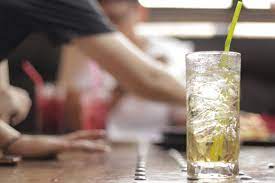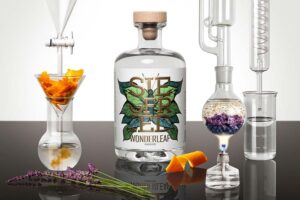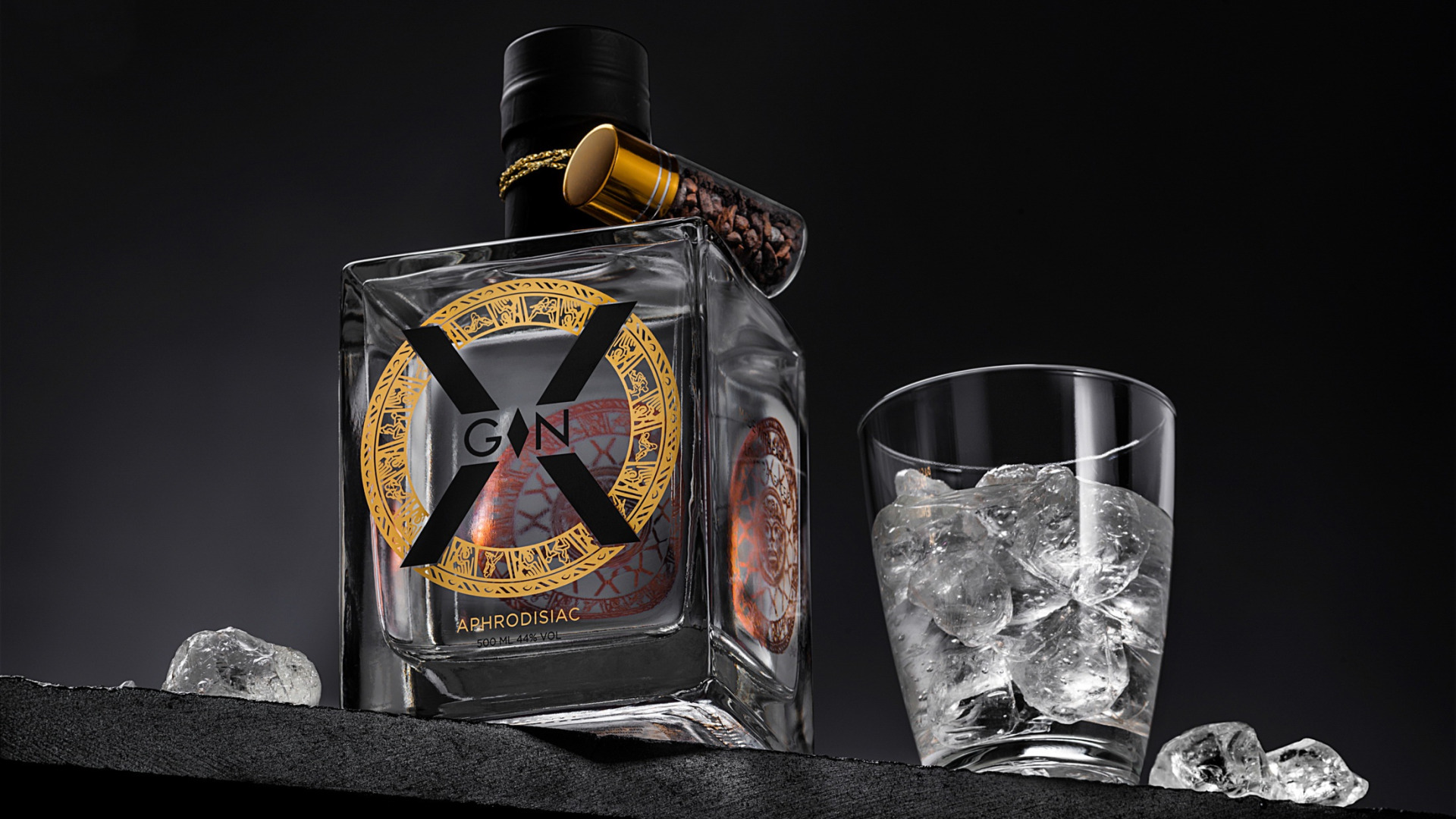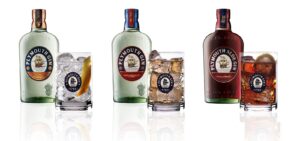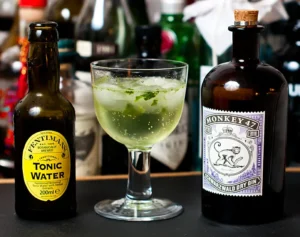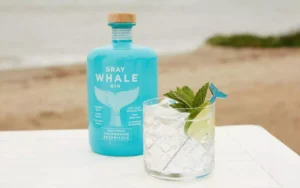Bring On The Good Times – With Top Botanicals In Gin
In recent years, there has been a surge in the popularity of Gin. More and more people ask nowadays about the kind of botanicals that go into making their favorite drink.
However, most gin brands do not like to mention the ingredients that went into production. They feel that this may give away their trade secret.
Nevertheless, to make gin you generally start utilizing a neutral spirit like vodka. Then you compound or add flavor by distillation utilizing berries, fruits, herbs, roots, and seeds. The most common herb utilized in the production of gin is juniper. Nevertheless, all additions that go into the production of gin are referred to as botanicals. This is why all gin brands feature a distinctive taste although vodkas blandly taste similar.
Alcohol merely acts as a solvent in most gin brands. It is the extract from the botanicals that provide the aromatic takeaway. Most botanicals are first boiled in the distillation column. The liquor is then collected and proofed down to make particular gin types.
Several botanicals go into the flavoring of gin. However, we are only going to discuss the most popular ones in this article.
How Are Botanicals Added to Spirits?
Maceration is the easiest method for making gin. Botanicals like citrus peel, crushed berries, crushed cinnamon, and ground juniper are added to the neutral spirit like vodka in a pot still for at least a night to a few weeks time. The mix is then distilled to derive the newly flavored alcohol. Subsequently, it is then diluted to the strength required.
Some producers mix all the botanicals at once. Then there are others who prefer to distill them separately and combine them at the end.
Nevertheless, vapor infusion is also utilized. This involves boiling the neutral spirit and then letting the steam rise through a basket containing botanicals. The liquor is then allowed to cool down. Condensing this liquid will infuse the flavors you wanted into the spirit. Moreover, this method brings more delicate flavors into gin.
You can also use some botanicals directly in a mix. Store it in a jar in a cool and dark place to create gin. However, this method takes a longer time if there is no boiling or evaporation involved. Nonetheless, you can still make gin through this cold infusion technique. This method is known as compounding gin.
Essential Botanicals Added To Gin
This is practically a base that makes gin. Most jurisdictions require a minimum of 80 percent juniper to be called gin. This botanical bill of juniper is required for the drink to qualify as a London Dry Style. Nevertheless, modern contemporary gins are bucking the tradition. They are choosing to use lower amounts of juniper in order to make room for other botanicals to create more exotic flavors.
Juniper berries typically are peppery and come with a sweaty scent. They taste semisweet and portray hallmarks of camphor, lavender, and pine. Juniper berries also convey an overtone of overripe banana alongside a spicy finish.
This prime gin botanical comes from the family of cypress coniferous trees. Most berries of this group are used in the production of gin. Juniper berries normally come from India, Italy, Macedonia, and Serbia. However, some of the best juniper berry crops come from Macedonia and Tuscany Mountain slopes.
Moreover, Asian juniper berries are cheaper and larger when compared to the darker European ones. Nonetheless, they are often preferred for cooking rather than gin making.
The normal season for handpicking juniper berries is from October up to February. However, it is good to start early when you are looking for fresh berries to be utilized in making gin.
It is also essential to note that the major flavor components in the berry are these three main oils:
- Alpha-pinene oil
- Camphor oil
- P-terpineol oil
These elements effectively combine to produce the distinctive piney taste of the berries that also distinctively transfer to gin as well.
Distillers normally purchase juniper berries by weight. Moreover, they normally keep the berries for about two years before using them in the production of gin. Some moisture during this time definitely gets lost but the oil content stays intact. These juniper berries in fact are more concentrated. This is also the reason why the resulting gin is more consistent in taste.
This is the second most essential flavoring agent that goes into the making of gin. Most of these seeds nowadays come from Bulgaria, Moldavia, Morocco, Romania, and Russia. However, the flavor largely varies based on the region they come from. For instance, coriander seeds coming from Bulgaria are likely to be more powerful than the seeds coming from Morocco.
The coriander flower is basically aromatic, fragrant, and spicy. The seed features a lemony candied ginger taste that is mellow with a sage. This seed essentially comes with linalool oil.
Smelling coriander often evokes a naan bread memory. This seed compounds a citrus addition to gin. However, some distilleries use citrus peel as a substitute for coriander because it is cheaper.
Most reputed distilleries however use crushed and roasted coriander seeds. This is what makes the flavor vary from one brand to another. A gin coming with a powerful coriander presence may be a surprise to many. Those who like will adorn the flavor, while others may choose to ignore it. Coriander seeds overall are a cozy supplement to juniper flavors.
The performance of coriander plays a significant role in representing an aromatic and sweet spirit. You will rarely find a gin that lacks coriander. Moreover, the tone of coriander is always nuanced in most brands. Coriander plants come with a one-of-a-kind flavor that transforms into a citrusy, nutty, and spicy flavor after distillation.
This strange but staple ingredient in gin is factually the bulb of the iris plant. It is as good a part of Chinese medicine, and perfume-making industry outside of gin. However, the orris root is not used much in the Western world.
Known as fixatives, orris root, and angelica root play a special role in the gin-making industry. This means that they help stabilize and lock flavors in gin. You would be hard-pressed to explicitly notice the taste of orris in gin, although some quantities of orris and angelica are both used in the process of making gin.
The perfumed aroma of oris root brings a subtle earthy nuance to the spirit. This root is almost like the ginger root, but the chalk-white inside of the orris root is distinguishable. The iris plant is about three to four years old when the bulbs are picked. They are then kept for about three years before being utilized in making gin.
Finally, the orris root botanical is extremely hard and needs to be crushed to powder before use. However, most often orris root is bought and used in powdered form by gin distilleries. Orris powder is easily identified by its milky brown color and chalk-dust texture.
Most botanicals used in making gin mainly come from Florence in Italy.
Orris root when eaten raw is extremely bitter. It tastes like cold stewed tea. This is why it often seems strange to go as a staple ingredient in making gin. However, only when orris root is combined with other botanicals and distilled that the magic of this staple ingredient happens to begin.
Several distilleries sing constant praises for this botanical. Mainly because orris root boasts of an ability to counter other botanical flavors. It tops as a floral fragrance note. Apart from being used in the making of gin, orris root with a strong scent is suitable for perfumes as well. There is an unfounded report that says the Chanel 5 perfume boasts of a high consistency of orris root.
This root is also popularly used by most gin distillers. Thanks to its fixative properties, it usually comes along with Orris root or by itself. Some distilleries even go to the extent of using angelica plant seeds and flowers as well. However, the roots of angelica are the most common and what we are discussing here.
The taste of the spirit with angelica root is earthy and herbal. This botanical is largely known to come from Flanders, France, Germany, and Romania. The angelica root is extensively used to fix a wide range of volatile flavors in gin.
The combination of these botanicals in the spirit brings along a blended and harmonious taste to the final product. Gin without angelica would end up tasting quite rough.
Nevertheless, the diligence of angelica root does not impact the quality of gin like coriander seeds and juniper berries. This is exactly what every distiller ends up celebrating.
If you have never tried a gin with angelica it is worth doing. This botanical like juniper comes with a very complex flavor. Master distillers say that angelica roots come with a bitter, yet herbaceous and sweet taste, alongside earthy notes.
Angelica roots have a distinct pungent aroma that is recognizable immediately. However, it may be confusing for people who do not know the difference. A jar of angelica root gives a similar smell to a freshly opened beer bottle. There is a damp earthiness involved that resembles some hop varieties as carried by ethanol.
With a sturdy stalk and countless flowers, the angelica plant grows oversized leaves. This plant can also be located in several normal gardens. However, most distillers only opt for it when it is in a drinkable format. Although angelica root is not widely used, it is still a good idea to try new gin flavors that can give us the feel of celery or a hop-like fragrance appeal of angelica.
These berries are not like peppercorns. Cubeb berries are also known as the java pepper or the tailed pepper. Originally from Indonesia, cubeb berries are now mostly grown around Java and Sumatra.
This plant is a long-living flower vine. Cubeb flowers contain hard and white oily seeds. These are normally dried, ground up, and used in food making, gin, and vodka.
Cubeb berries taste far more complex than pepper which is simply hot and spicy. This gin-botanical for some people tastes more like allspice than pepper. Or you can say that cubeb berries are somewhere in between.
Gin with cubeb berries for newcomers might taste similar to gin with pepper. However, there are numerous other flavors under the surface. This botanical can sometimes taste like flowers, lemon, or pine. Nonetheless, it tastes more like pepper than anything else.
Quite often, a small amount of cubeb berries is enough. As little as two grams of crushed cubeb berries are normally used in the botanical mix while distilling or vapor-infusing gin.
Citrus Elements In Gin
Lemon is one of the standard botanicals in London Dry Gin. It plays a very fundamental role in raising this spirit. However, lemon peels are well-dried out before they can be used. This lemon addition is exquisite, unlike the orange. It delivers a hint of bitterness and dry freshness to the gin.
You will immediately be able to notice the flavor of lemon on the nose in gin when it comes to aromas. Nevertheless, it disappears with the first taste before you are done with the sip.
The lemon twist eventually adds a taste of citrus flavor to the spirit. But why should we go for the dried lemon peel? This is because dryness ensures that the moisture is completely removed, and the dry peel is where all the essential oils are concentrated. This citrusy gin botanical thereby comes with a bitter and crisp note that is only unique to gin.
Several gin distillers acquire this botanical from a company located in Southern Spain. It is because this geographical location is most suitable as farmers here generally hand-peel the fruits and sun-dry them. You can therefore expect to get citrusy, juicy, and lemony flavors to your gin with the addition of lemon peel.
After the skin is peeled off the lemon, you will need to dry it well before you can distill and infuse the essence in the spirit. Remember that lemon peel is among the top five widely used botanicals that go into flavoring gin.
The lemon peel happens to top up to an easily recognizable citrusy fresh tart note with an unmatched crispness. It is also able to offset the strong juniper notes with earthier bitter and citrusy notes of lemon.
This citrusy peel is also mostly procured from Seville in Spain where the oranges are normally picked around the month of March every year. However, most distillers select different orange types. Some opt for sweet while others prefer the bitter variety. Nevertheless, the gin gets a new life with orange peel. It becomes more juicy and warm with flavors.
However, it is prudent not to forget that like lemon only dried orange peels are used in making gin. Moreover. Mostly sun-dried peels are preferred as all the moisture content is effectively removed from the peel without leaving a pungent smell.
The orange peel not only renders the gin to be bright in quality but also plays a major role during the distillation procedure. This gin botanical is also trendy like the lemon peel. Additionally, the process of removing the orange peel is comparatively easy. All you need to do is remove the peel with a very sharp knife along with the attached pith.
The orange peel imparts a bitter taste to the gin. However, this is mostly true only when the Seville oranges are used. Other sweet varieties of oranges may leave a semi-sweet flavor in the spirit. The orange peel is also enriched with essential oils. It stands out from other herbs and spices since it adds flavor to the spirit.
Moreover, orange peel also tends to strengthen other flavors to perfection in the gin. Nevertheless, orange peel is often underrated and neglected, but still plays a key role when it comes to driving gin flavors to the next level. This is why several brands regard this botanical as a unifying factor while prescribing the flavor profile of their gin.
Elementary Florals In Gin
The petals of this flower are largely associated with a calming tea. Moreover, it works as a herbal medicine as well and is commonly used as a remedy for sleep.
Chamomile flowers are native to Europe. They not only grow everywhere but are cultivated as well. It is very easy to grow these flowers from seeds. Quite a few varieties of this plant can grow in poor soil too. Chamomile flowers are normally white and yellow and grow along feeble green stalks.
Most often Chamomile flowers taste similar in gin as they do in tea. Especially when they are used in isolation. Effectively, these flowers soften the aroma of the gin by adding a floral smell. Quite a few times, Chamomile in gin can smell like apple or hay.
Adding chamomile to gin can easily be done without equipment. You need not add fresh hazelnut leaves or require a still. Just put about 15 or 20 chamomile tea bags into 750 ml of gin or vodka and leave the mix overnight. The chamomile tea leaves will seep into the mixture without heat. Nevertheless, this takes far more time than when you are brewing tea.
This flower is yet another one of the most common botanicals in gin. Lavender is normally a herb used as a remedy for anxiety, insomnia, pain, and stress. It is commonly prescribed in alternative and traditional medicines. Lavender flowers are usually picked up and used in cosmetics, perfumes, soaps, and other hygienic produce. They are also nowadays used to add an incense quality to the spirit of gin.
Not all types of lavender flowers are just as good as the others. Especially so when you are making gin. The English variety of lavender flowers is much better. Moreover, it is best if you pick them up when the plant is in full bloom. They work best when used fresh or dried immediately after plucking to lock in the flavor.
Most of us are familiar with the smell of lavender. But how does it taste like in gin? Well, it gives a fresh and light aroma to the spirit, and which is not sweet. The gin now imparts a very floral taste. What lavender does to the spirit is more similar to rose than to other botanicals. Nonetheless, you can easily spot the difference between the two of them. Lavender may often remind you of soap and perfume in a positive way.
This is a tall flowering plant normally cultivated for its flowers. Hops are well known to be utilized during the beer-making process. Though fairly old, hops have not been used for thousands of years. Hops seem to have been cultivated since the ninth century. They were first cultivated in Europe.
Mostly used for making beer, hops nowadays are also used in harder drinks as well. They impart a citrusy flavor to gin that may remind you of an Indian pale ale. The taste of hops in gin generally depends on how the spirit is made.
Adding hops to the spirit after distillation imparts a bitter flavor to gin that may remind you of an Indian Pale Ale. However, you get a sweeter gin with a more citrusy floral flavor when you add hops before distillation. Add hops at the end after all other botanicals have been distilled if you want a spirit that reminds you of an IPA.
Use about half an ounce of hops per 750 ml of vodka while making gin. You may precipitate the mix for about a day or two but use a filter to separate the content.
Herbal Elements In Gin
Since ancient times ginger has been grown in several parts of the world. However, it was first cultivated in Southeast Asia. This certainly began thousands of years ago from now. Ginger is the root of a yellow-flowered plant that grows about a meter tall in height.
Cultivation of ginger soon spread across long distances at an early age. It spread far west to Europe during the first century AD and reached East Africa as well. Ginger today is largely cultivated in China, Indonesia, Nepal, Nigeria, and Thailand. However, India is the largest producer of ginger as of now.
Ginger root contains medicinal properties. Moreover, it is also used to flavor several dishes. Normally credited with plenty of medicinal effects, some of these are also backed by strong evidence. First of all, ginger prevents nausea and vomiting by affecting the nervous system. Many people also utilize ginger root juice as a remedy for diabetes, migraines, and various types of other problems.
Additionally, ginger is an important part of Caribbean and Indian cuisine. Then there are many other countries having dishes that include ginger. Ginger root juice is spicy in a distinctive way. It is quite different from various other spicy foods.
Commonly used to flavor gin, ginger gives a unique spicy but partly sweet taste to the spirit. You could not get this flavor from anything else. It is true that ginger adds the same flavor to gin as it does to food. The right gin may even remind you of an Asian meal.
Although they taste different, one can use either fresh or dried ginger in gin. Fresh ginger has a very pungent smell and taste but dried ginger is a bit less intense. It has a peppery taste. Ginger root juice is both spicy and sweet. It is therefore one of the most popular botanicals going into making gin.
This gin botanical is known to have originally come from India and Southern Europe. Licorice root juice is quite sugary and almost like anise or fennel. This gin botanical flavor is way further from the candy aroma. You can expect it to give a larger viscous texture to the spirit. Licorice is one of the most interesting plants to distill while making gin. However, it is taken for granted that the plant fails to offer any flavor, this botanical yet delivers an incredible sweetness to the spirit. Moreover, licorice comes in a wide range of flavors, unlike candy.
Licorice ensures that the spirit is pleasant and viscous. Nonetheless, note that the flavor found in gin is not the same as you find in sweets if you are a diehard fan of licorice sweets. The gin alternative is entirely different.
The flavor of licorice in gin is strong and distinctive. So avoid using too much. It is better that you err on the side of too little. Moreover, licorice will also add heat and burn to the finish. So, be careful not to overdo it since you will also be working with other spicey elements like chilly, ginger, and pepper.
Licorice is also sourced from the Indo-China region. In order to prepare for distillation, the roots of the licorice plant are ground into a fine powder. Apart from making gin pleasant and viscous, licorice also makes the spirit taste bittersweet, earthy, fresh, light, and woody. It adds base and length as well alongside softening, sweetening, and rounding off the gin. Another unique aspect of licorice is the fact that all its flavors are held together by glyceric acid. This element is often low in content to most essential oils.
Elementary Spices In Gin
It is possible that Black Pepper originated in India. But it is now widely grown in Vietnam. These plants are vines that give small seeds called drupes. They are normally picked early and cooked before they dry out. Black pepper contains piperine. It is an aromatic compound said to have medicinal properties.
As the most traded spice in the world, black pepper has been used in food for the last 4000 years at least in India. Moreover, this spice is also a pervasive food item all over the world, especially in food from the Western world. Black Pepper in combination with salt works to flavor almost anything that is not purported to be sweet.
People across the world credit black pepper with medicinal properties. However, this is not backed up by evidence but may still be true. Nonetheless, black pepper is often used to aid sleep or as a treatment for toothaches. It is also found in skincare products because it is thought to treat sunburns.
Black pepper is also commonly used in traditional gins. Especially the London dry gin custom. The terpene piperine in pepper gives the spirit a strong flavor. It gives an alkaline, bitter, and spicy taste to gin.
Peppery gin is presumed to be piquant. It is warm and pleasantly stinging. Gin with pepper as a botanical appears to be a bit harsh and is slightly painful to consume.
However, pepper does not have an unlimited shelf life. But it can last for years if properly stored in an airtight container within a cool dark place.
This variety is different from black peppercorns. It comes from an unrelated plant that is native to South America. Pink peppercorn is not really pepper. Moreover, it is a less common gin botanical and not often used as black pepper.
Every gin has a flavor profile. It roughly depends on measures of five to six botanicals including citrus, floral, fruit, herbal, juniper, and spice. They contribute to the taste of the spirit.
First and foremost, peppercorn gin is spicy. Although, it may also be floral. Gin containing pink pepper botanical is aromatic. It has a rich and bitter taste. Quite often gin is mixed with quinine like in Gin & Tonic. The bitter taste of tonic water containing quinine goes well with peppery gin. Moreover, tonic water is also sweet and sugary. The relatively mild Pink Peppery gin adds to the overall taste of this mixed drink.
Pink peppercorn does not release its flavor without heat. This is why you will need to have this botanical during the distillation process. You are required to add about three tablespoons of pink peppercorns for every two cups of the spirit or about 3 ounces of pink peppercorns for every liter of vodka.
This spicy gin botanical comes from the ginger family. Cardamon pods have an exclusive taste that can be comfortably identified in the spirit. Native to Indonesia and India, these seeds can also be found in Guatemala, Indo-China, and Tanzania. Moreover, cardamon comes in both black and green varieties. The green ones are however mostly used in the production of gin. The green cardamon variety is blessed with a delicate flavor and a fragrant aroma.
It is not difficult to explain what cardamon does to the spirit apart from the smell and taste. This spicy gin botanical has been there for years. You are bound to come across this spice if you happen to travel to the southern parts of India. With a medicinal and numbing taste, bright green cardamon pods are added to gin. Additionally, cardamon imparts a very aromatic and strong flavor to the spirit. It also makes gin taste citrusy. The only other botanical that is close to cardamon is eucalyptus.
Apart from being utilized as a gin botanical, cardamon pods are used in coffee, food, and perfumery industries. Cardamon pods are normally harvested by hand. Thereafter they are dried using sunlight. These pods are then broken open to give the black seeds of the cardamon. October to February is normally the harvesting time for this plant. However, the timing may vary from country to country depending on the climatic conditions. The Latin name for Cardamon is Elettaria Cardamomum.
This spice originates from Ski Lanka. Cinnamon offers a spicy taste to gin. The bark of cinnamon spins into quills as compared to cassia trees. This plant needs no introduction, unlike various other gin botanicals. People love the spicy and warm notes this botanical imparts to gin. It is also said that this plant is from the laurel family. This is why you may notice a few cinnamon flavors in the leaves found in the bay. Cinnamon was brought to Egypt about 4000 years back. It has still been the main ingredient in the spice market ever since.
The cinnamon plant plays a crucial role in complementing the testier notes found in the gin. It gives a burning spicy tone to the spirit. Most distillers declare that the flavor of cinnamon is gentle. However, it is easy to distinguish between cinnamon and cassia. So don’t miss trying out gin with cinnamon in it, if you need to have a mind-blowing flavor of the spirit.
Elementary Nuts In Gin
This tree is quite close to the peach tree. The Almond tree is known to have originated from the South-West Asia region. However, the types of almonds used in gin are both, bitter and sweet varieties. Both these varieties are very hard and are required to be grounded before they are added as botanical to gin.
Almond nuts are blessed with a high amount of essential oils. They give the spirit marzipan-like nutty, soapy, and spicy flavor to gin. Additionally, the use of almond nuts provides a thickness and viscosity to gin. Almonds also impart a mouthfeel to the final spirit.
This elementary gin botanical also provides a delectable softness to the spirit. Normally one or two almonds are used per litre of final spirit. It helps mingle up the other flavors as well before creating a much more rounded quality of the final liquor.
Interestingly, there are two key types of almonds available in the market. Bitter, and sweet. The sweet one comes from the Dulcis variety of the ‘Prunus Amygdalus’ almond tree. However, it does not contain any poisonous chemicals at all. The bitter almond variety comes from the ‘Amara’ almond tree type. These nuts do contain a good amount of a highly toxic chemical known as a precursor to cyanide.
This compound is known as amygdalin. It is present in higher amounts in bitter almonds. This chemical itself is what gives a bitter taste to the nut. When this compound is ingested, it breaks down into many chemicals. Including benzaldehyde, which tastes quite bitter, and cyanide which is commonly known to be a deadly poison.
Most gin spirits use sweet almonds. This is because these nuts do not undergo any genetic mutations. They add more to the somewhat subtle, creamy exotic vanilla-tinged flavor of the almond orgeat and syrup to the spirit. Bitter almond, on the other side, is from a different almond tree variety. It has proven beyond doubt that bitter almonds contain quite a few toxic chemicals.
Harvesting almonds is simple. The nuts are shaken off the plant and then given some time to dry on the ground. They are then placed in rows to be collected with the help of a tractor after drying normally. Lastly, they are sorted and cleaned before being peeled and milled at the industry level. Waste almonds are commonly used as animal feeds or utilized by the confectionery industry.
These nuts grow on tall trees. Hazelnuts have been widely used for the last 8000 years at least. Year after year more than a million tons of hazelnuts are harvested across the world. Almost 70 percent of the total produce comes from Turkey.
Hazelnuts are normally roasted by people. They either eat them raw, grind the nuts into a paste, or convert them into oil before consuming. Several food items contain hazelnut oil in numerous countries across the world. You can also use hazelnut oil for cooking.
This nut is a more common botanical in making gin than normally thought. Some popular gin brands like Bombay Sapphire are infused with hazelnuts. Nuts are not a rare choice of botanicals making gin. However, hazelnut gin subtly reminds you of the taste of Nutella and quite a few other nut spreads that are made up of these elementary nut varieties.
You can also use shelled hazelnuts while making gin. The nuts are first toasted and then ground up prior to adding. Hazelnut liqueur normally uses 400 gms of hazelnuts along with 750 ml of brandy and vodka. Forming Hazelnut gin is similar to making liqueur, minus the sweeteners and without brandy as well.
This nut variety is native to Australia. People here have commonly been eating these nuts since long before the European connection. The macadamia nut tree was first introduced to Hawaii in the 1880s. This region is where it was largely produced for a long time after that. Almost 160,000 tons of hazelnuts are now harvested each year. These mostly come from South Africa and not Australia or Hawaii.
Noticeably, macadamia nuts are hard to break open. They are much harder than hazelnuts. Although you can break open a nut with force, but it will not open as conveniently as other nuts do since the shell of this nut is very tough.
Macadamia nuts as a botanical give gin a nutty and savory tang. However, it goes very well with vanilla which is also quite common in various types of spirits. Macadamia nuts typically taste sweet and soften the aftertaste of a bitter gin.
The gin tastes better with fresh macadamia nuts. These nuts are roasted before they are added to the still. However, this is normally done while the nuts are fresh.
Keep Your Bottoms Up
We have tried to provide you with a complete guide to the gin botanicals that are commonly used. This should help you find the best gin varieties across the globe.
From citrus to spice or nutty to sweet, there is always a botanical that can provide the perfect balance to your gin.
It doesn’t matter whether you are a keen distiller, or simply trying to hone your craft. Even an excited gin drinker can find out a little more about what goes into their booze. We hope that this guide has been helpful.

